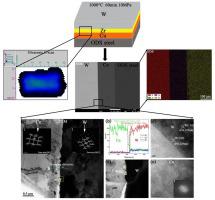Journal of Materials Processing Technology ( IF 6.3 ) Pub Date : 2021-08-27 , DOI: 10.1016/j.jmatprotec.2021.117341 Jingwen Zhang 1 , Liming Yu 1 , Yongchang Liu 1 , Chenxi Liu 1 , Zongqing Ma 1 , Huijun Li 1 , Zumin Wang 1 , Dijun Long 2

|
Bonding of tungsten (W) with oxide dispersion strengthened (ODS) steel is an urgent challenge during the practical manufacturing process in many applications, including advanced nuclear reactor systems, military equipment, etc. To eliminate the generation of brittle intermetallic compounds Fe-W and relieve the residual thermal stresses, a novel composite interlayer Zr/Cu, for bonding W with ODS steel using the transient liquid phase (TLP) diffusion technology, was designed in this work. The bonding materials were prepared as a sandwiched structure of W/Zr-Cu/ODS steel in a vacuum diffusion bonding device. Interfacial structure and tensile strength of the bonded joints were investigated, and the processing parameters were optimized. After the bonding process, a reliable Cu/ODS steel interface could be built at all applied temperatures or holding times. Nevertheless, only as the bonding temperature was 1000 °C or even higher, the inserted Zr foil could be completely consumed and a stable W/Cu interface free from intermetallic compounds and micro-cracks was built. Additionally, the bonding ratio was gradually improved with increasing the bonding temperature or holding time. As a result, a high-strength W/Cu/ODS steel joint of ∼430.4 MPa could be fabricated at 1000 °C for a holding time of 60 min, and the bonding ratio was as high as 98 %, which provided a significant guide for the assembly of plasma facing components (PFCs).
中文翻译:

通过插入新型复合夹层 Zr/Cu 实现 TLP 扩散技术制备的 W 和 ODS 钢的稳定结合
钨 (W) 与氧化物弥散强化 (ODS) 钢的结合是许多应用实际制造过程中的紧迫挑战,包括先进的核反应堆系统、军事设备等。 消除脆性金属间化合物 Fe-W 和为了减轻残余热应力,本工作设计了一种新型复合夹层 Zr/Cu,用于使用瞬态液相 (TLP) 扩散技术将 W 与 ODS 钢结合。结合材料在真空扩散结合装置中制备为 W/Zr-Cu/ODS 钢的夹层结构。研究了结合接头的界面结构和抗拉强度,优化了工艺参数。在粘合过程之后,可以在所有应用温度或保持时间下构建可靠的 Cu/ODS 钢界面。然而,只有当接合温度达到1000°C或更高时,插入的Zr箔才能完全消耗,并建立稳定的W / Cu界面,没有金属间化合物和微裂纹。此外,随着接合温度或保持时间的增加,接合率逐渐提高。结果表明,在 1000 °C 保温 60 min 的条件下,可以制备出 ∼430.4 MPa 的高强度 W/Cu/ODS 钢接头,结合率高达 98%,这提供了重要的指导。用于组装面向等离子体的组件 (PFC)。插入的 Zr 箔可以完全消耗,并建立稳定的 W/Cu 界面,没有金属间化合物和微裂纹。此外,随着接合温度或保持时间的增加,接合率逐渐提高。结果表明,在 1000 °C 保温 60 min 的条件下,可以制备出 ∼430.4 MPa 的高强度 W/Cu/ODS 钢接头,结合率高达 98%,这提供了重要的指导。用于组装面向等离子体的组件 (PFC)。插入的 Zr 箔可以完全消耗,并建立稳定的 W/Cu 界面,没有金属间化合物和微裂纹。此外,随着接合温度或保持时间的增加,接合率逐渐提高。结果表明,在 1000 °C 保温 60 min 的条件下,可以制备出 ∼430.4 MPa 的高强度 W/Cu/ODS 钢接头,结合率高达 98%,这提供了重要的指导。用于组装面向等离子体的组件 (PFC)。



























 京公网安备 11010802027423号
京公网安备 11010802027423号